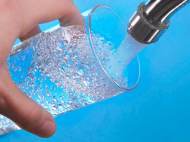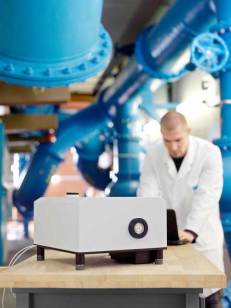Lasers test potable water automatically on the spot
 Researchers at the Fraunhofer Institute have used a quantum cascade laser, a particular type of infrared laser, in analysis equipment that can automatically test samples of drinking water for contaminants. This technology analyzes water samples at the waterworks itself, and it needs only a couple of minutes to determine whether water contains any impurities and what those impurities are.
Researchers at the Fraunhofer Institute have used a quantum cascade laser, a particular type of infrared laser, in analysis equipment that can automatically test samples of drinking water for contaminants. This technology analyzes water samples at the waterworks itself, and it needs only a couple of minutes to determine whether water contains any impurities and what those impurities are.
To keep drinking water clean, experts are constantly monitoring our supply to check it for contaminants. Water quality is usually examined by means of molecular spectroscopy – a method that examines the optical spectra of the molecules in the water. Each chemical compound has a unique spectrum, since individual molecules vibrate and absorb light at characteristic frequencies.
Water itself is a very strong absorber of infrared light, and the researchers from the Fraunhofer Institute for Applied Solid State Physics IAF (Fraunhofer IFA) used infrared radiation to analyze impurities in the water. Since the light sources employed to date have delivered little power, examinations of this sort have been possible only in a laboratory setting.
“The main sticking point is the intensity of the light. In order to be in a position to employ molecular spectroscopy at the waterworks itself, we needed to find a more powerful light source”, said Frank Fuchs, Fraunhofer IAF coordinator for the IRLSENS project. The objective of IRLSENS project is to develop a measuring system for the early detection of terrorist attacks against the drinking water supplies.
Fraunhofer IAF’s quantum cascade laser produces light that is up to 1,000 times more concentrated than the silicon carbide thermal emitters used in the laboratory to date. Its measurement system is only a little larger than a shoebox, can be set to work automatically, and requires hardly any maintenance. This new system’s advantages lie in fast analysis, specialization in a particular group of substances, and automation.
A demonstrator has already successfully undergone initial practical testing. At the Kleine Kinzig waterworks in the Black Forest, tests were conducted on various concentrations of sweetener as a stimulant substance. Measurements were taken every three minutes over a period of six weeks, with the fully automated system collecting a total of 21,000 samples. According to the Fraunhofer IFA researchers, the test results were excellent. Every sample was recorded in perfect detail, and there was not a single error.
Even the concerns regarding the vulnerability of the laser spectrometer to vibrations were proved unfounded, since the machines and pumps had no influence on the test results. Providing there is sufficient demand, project partner Bruker Optik, the company that built the demonstrator, would like to develop the measurement system into a commercial product.










Leave your response!